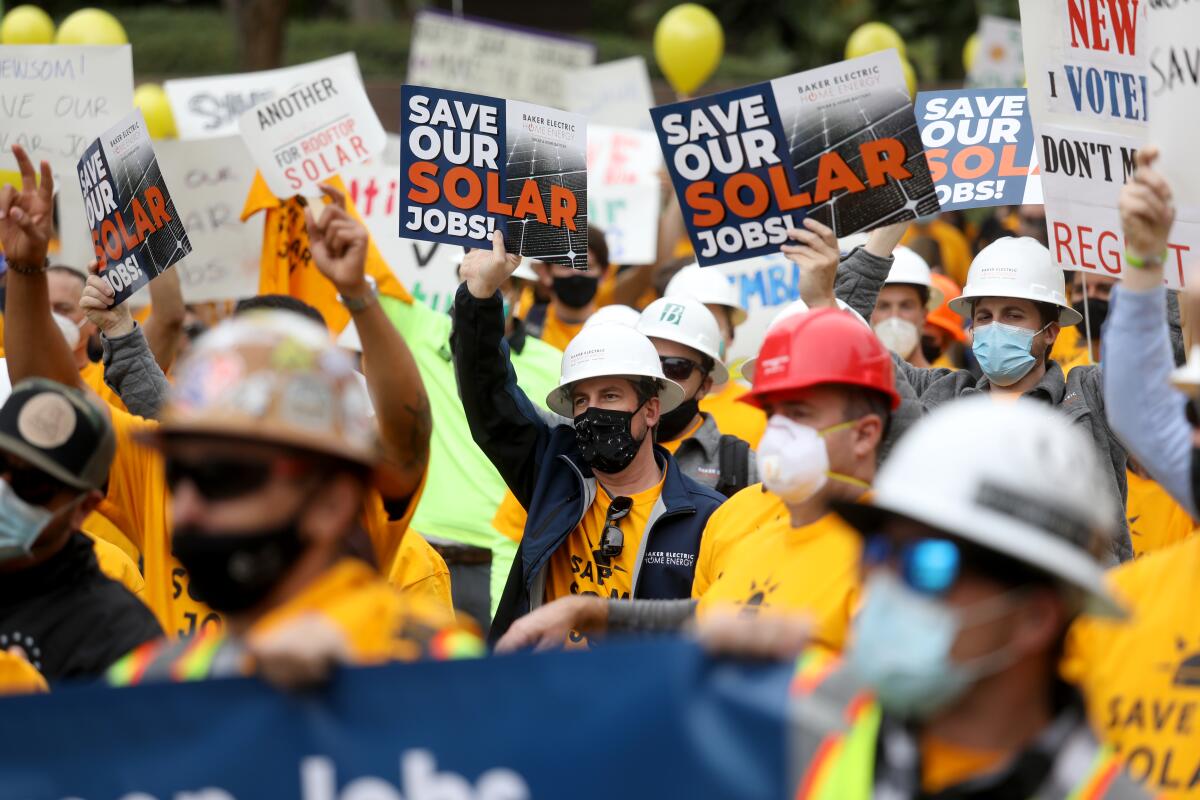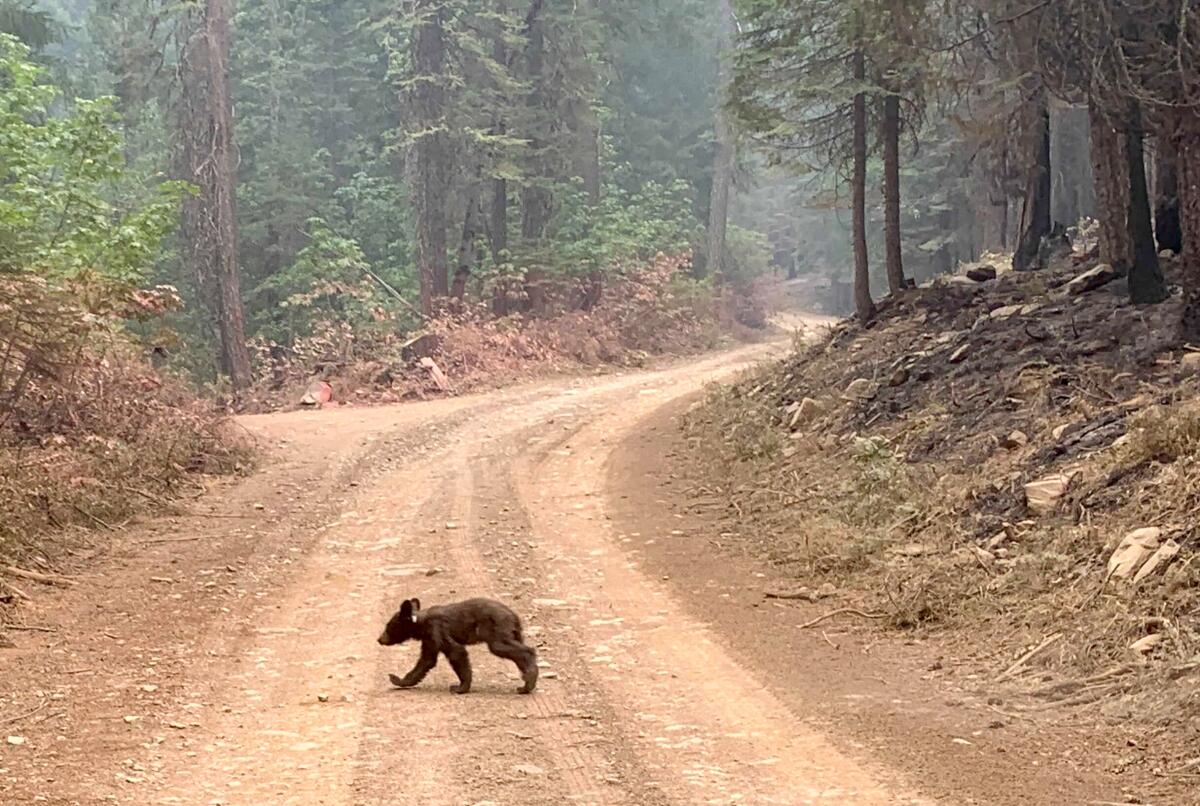Newsletter: Should California slash rooftop solar incentives? We took a survey

This is the Jan. 20, 2022, edition of Boiling Point, a weekly newsletter about climate change and the environment in California and the American West. Sign up here to get it in your inbox.
A high-stakes battle over California’s clean energy future is nearing its endgame.
The state’s Public Utilities Commission has proposed major cuts to a rooftop solar incentive program called net energy metering, with a vote expected soon. The solar industry and its supporters staged large rallies in Los Angeles and San Francisco last week, urging Gov. Gavin Newsom and his appointees to preserve net metering. Celebrity solar advocates are weighing in too, with the actor Edward Norton writing a detailed Twitter thread and Mark Ruffalo — who, like Norton, has played the Hulk — tweeting that someone should “have a stern talk with” Ralph Cavanagh of the Natural Resources Defense Council, a critic of net metering.
Meanwhile, Newsom is facing pressure to gut the solar program from organized labor and utility companies including Pacific Gas & Electric and Southern California Edison. The governor made his first public comments on the issue last week, saying only that “changes need to be made” to the proposal to cut solar incentives and add monthly fees for solar-powered homes.
The Public Utilities Commission is nominally an independent agency, but Newsom appoints its five members. He recently named his energy adviser Alice Reynolds as the agency’s president and appointed John Reynolds (no relation) to an open seat.

If all this is new to you, see my recent story on the arguments for and against revamping net metering.
It’s a debate that has inspired tremendous passion, especially among people who have solar panels or hope to install them one day. So last month I asked readers of this newsletter to fill out a survey sharing their views on the idea of reducing incentives.
As of Tuesday afternoon, we’d received more than 1,300 responses. Here’s what everyone had to say:
- Do you agree with the Public Utilities Commission’s proposal to slash rooftop solar incentives?
- Yes: 3.1%
- No: 86.2%
- Partially: 10.5%
- Do you have rooftop solar?
- Yes: 63.2%
- No: 36.4%
- Do you work for a solar company or an environmental group?
- Yes: 11.7%
- No: 87.8%
This isn’t a scientific survey. The pool of respondents is far from random, especially considering that 63% have rooftop solar.
Still, the results show just how much the commission’s proposal has stirred up regular Californians who support rooftop solar — especially considering almost everyone who filled out the survey took the time to add written comments too.
I haven’t made it through all 1,300-plus written responses, but I’ve read more than half of them. Here are some key themes:
- Hatred of PG&E, Edison and San Diego Gas & Electric. Many, many people who took our survey despise these companies, either because of the high rates they charge for electricity, the deadly wildfires they’ve ignited or their history of fighting rooftop solar — or all of the above. Lots of folks called for California to ditch profit-driven monopoly utilities entirely.
- Intense frustration with the Public Utilities Commission. Many respondents suggested the agency is either incompetent or controlled by the utility companies it’s supposed to be regulating.
- Visions of a different kind of energy future. Specifically, a future where much more electricity is generated on-site by homes and businesses, rather than at faraway power plants. Benefits could include fewer sprawling solar farms destroying wildlife habitat in the desert and fewer long-distance transmission lines sparking wildfires.
- Anger from existing solar customers. The proposal to end existing net metering arrangements after 15 years rather than 20 (except for low-income homes) is galling for these homes and businesses. They spent tens of thousands of dollars on solar, and now they feel they’re having the rug pulled out from under them.
- People who had hoped to go solar but won’t if this decision is approved. Many, many survey respondents said this.
- Demands for climate action. More than anything, respondents talked about stemming the climate crisis. Why, they asked, would California do anything to slow down clean energy?

People who support the commission’s proposal largely echoed arguments made by the Natural Resources Defense Council, the one major environmental nonprofit calling for sweeping changes to net metering. NRDC says the program is largely paid for by lower-income families who can’t afford solar, and that California ought to promote rooftop solar in a way that doesn’t benefit the rich at the expense of the poor. Prominent ratepayer watchdog groups have made a similar case.
Here are selections from a few survey responses that stood out to me, lightly edited for clarity:
- Beatrice C.: “California is looking at higher temperatures. We will need to use air conditioning more. Elderly and sick people are especially susceptible to heat. Many elderly are on fixed incomes and cannot afford high bills during the increasing periods of hot weather. Many customers were encouraged to invest large sums in solar to be good citizens and help improve issues with grid instability during high-use times. It is unfair to change the terms of the agreement.”
- Patrick D.: “Many other states follow California’s lead. When California gets it wrong, others will get it wrong, too.”
- Nicole H.: “I invested $40,000 to do the responsible thing, and I’m providing excess solar energy to my neighbors! Why should people who have done the responsible thing now provide energy for free?! If they really want to own solar energy, let the utilities pay to install solar on all homes! I actually had to install new roofing to do this! The utility companies have a lot of nerve.”
- Pam B.: “We are climate activists and decided it was time to walk the talk, and not to worry about financial calculations. We are retired and projections of payoff for our investment reached beyond our lifetimes. ... We are in a climate emergency. California needs to face that fact and show leadership.”
- Jake A.: “There are thousands of jobs that the proposed decision will eliminate. This includes engineering positions, installer positions, electrician jobs, administrative staff, accountants, procurement jobs, etc. I work for a small electrical contractor — we have averaged about $11 million in solar revenue. The proposed decision would severely cut into this, not only for us, but for contractors all over the state.”
- Don Y.: “I have rooftop solar. This new proposal will stop my neighbors from installing solar and helping the planet. We need more solar panels on home rooftops, not fewer. This proposal serves the interests of the current monopolies, not the people of California. Serve the people and the planet will heal. Serve the monopolies and the cancer will grow.”
- Scott K.: “The big utilities are screwing California for profit. If they really wanted to help the poor, they would slash their egregious rates and stop giving CEOs all that yacht money.”
- Ronald M.: “Even if subsidies are needed to keep solar energy to be a good bargain, that is the most important expenditure of state funds imaginable considering the seriousness and urgency of the climate crisis that is facing the human race, now and even more in the future.”
- Shoshana W.: “The Public Utilities Commission is a disgrace with its relentless coddling of the investor-owned utilities. Its attack on solar is just the latest of a series of terrible decisions that are undoing climate progress in our once-beautiful state. And by the way, I want to see the solar industry unionized. One can take a both/and position on labor and environment.”
- Meladee N.: “I was considering solar. If this passes, so will I — not worth it!”
- Matt K.: “While I understand this ‘poor subsidizing the rich’ point that the utility companies are making, it feels like a strained argument to just get what they want. If that’s the issue, then why don’t we address that directly by funding more installations in those areas and move toward a distributed and equitable power grid?”
- Brittany R.: “We are a family of four earning less than $100,000 a year (public servant) who installed solar two years ago with one backup battery. ... Even though we pay a little more monthly now with solar plus battery than we paid before installing, we thought with rising energy prices and by staying in our home for 20 more years, the system will eventually pay itself off and we would have one lower utility expense in a very expensive state to live. This is now being taken from us. ... Overtime shifts will be required to keep it from coming out of our family budget.”
- Cody H.: “The Public Utilities Commission should be tarred and feathered for siding with the utilities on this.”
- William S.: “Reducing rates paid to solar owners for excess production may be warranted, but the additional changes are simply usury by incompetent utilities whose most significant accomplishments include blowing up Bay Area neighborhoods and burning down our forests. ... My wife and I are both retired. We were getting ready to go solar but these changes will make that impossible for us.”
- Monica C.: “Do we want to see a Google Earth photo of millions of solar panels on private rooftops, or do we want to see a Google Earth photo of all of our deserts covered with solar farms?”
- Leslie A.: “In order for me to purchase an electric vehicle, EV charging infrastructure, a solar system and two Tesla batteries on my small nonprofit organizer salary, I had to refinance my house to withdraw equity. ... I think it’s within reason to expect I’ll see PG&E bills double, while being painted as a wealthy coastal radical who doesn’t care about vulnerable populations.”
- Sophie G.: “You make an expensive investment for both the planet and yourself in the long term, but California would like to tax even more with unfair monthly fees??? PG&E is not even reliable, cutting power whenever it is too hot or too windy or too rainy. What country do we live in, seriously?”
- Natalie F.: “I’m working class. I made solar a priority. But I am far from rich. Solar is affordable now, it’s an option for people like me. It’s a realistic and reasonable way of generating energy and reducing our dependence on fossil fuels. I don’t much care if it cuts into PG&E’s profits.”

And here’s what a few people who support the Public Utilities Commission’s proposal had to say:
- Peter D.: “It seems pretty clear that when the fat cats and their mansions have solar panels, they force the poor people without the panels to absorb more of the fixed costs of the utility companies.”
- Jeremy L.: “If high-income families can afford to install rooftop solar, then they should pay for the full project, not expect lower-income families to subsidize them. They can afford to pay for it themselves, and not expect government taxpayer dollar subsidies at all. I see it in my neighborhood — the ones with rooftop solar own Teslas and high-value cars, plus they own the most expensive houses in the tract.”
- Billi R.: “In some ways, rooftop solar net metering is just another way to enhance wealth for predominantly white property owners. We need to find equitable solutions that benefit people who do not own their rooftops and do not have access to capital. This is especially true for people of color who have been excluded from the intergenerational benefits, including wealth generation, of home ownership.”
Whatever the utilities commission does next — whether that’s voting on the current proposal, revising the proposal or releasing a competing “alternate” decision — you’ll hear about it here. I’ve also got a standing request for an interview with the commission’s new president, Alice Reynolds. If and when she agrees to talk with me, I’ll write up the Q&A.
Until then, here’s what’s happening around the West:
TOP STORIES

California has 30,000 to 40,000 black bears, the most in the nation. But more bears than usual were killed by cars last year as they fled the fire-ravaged and drought-scarred Sierra Nevada looking for food before hibernation, Louis Sahagún reports. This sentence in particular really made me stop: “Unable to fend for themselves, orphaned cubs stay close to their dead mother, making sounds that eerily resemble those of human babies crying, biologists say.” In better news, The Times’ Susanne Rust writes that Ecuador is expanding the Galapagos Marine Reserve by nearly 50% in a move that will help protect sharks, turtles, fish and marine mammals. Susanne previously wrote about the threat posed to Galapagos wildlife by a massive Chinese fishing fleet.
Earth still hasn’t had a colder-than-average year since 1976 — and the last nine years are nine of the 10 hottest on record. See this story by my colleague Hayley Smith for the latest global temperature numbers. Despite the escalating climate crisis, the Biden administration has in many ways yielded to the demands of the oil industry, Nicholas Kusnetz writes for Inside Climate News. On the other hand, the administration just announced several initiatives to speed up construction of renewable energy facilities on public lands and waters, including offshore wind farms along the California coast, per Heather Richards and Peter Behr at E&E News. You may recall I wrote last month about the slow pace of solar and wind project approvals since Biden took office.
A history of lead pollution and environmental racism continues to haunt the Orange County city of Santa Ana — but Latino residents are working toward a better future. In a superb piece of journalism for Grist and Voice of OC, Yvette Cabrera collected 1,600 soil samples around Santa Ana over seven years to test for lead contamination, then wrote a searing portrait of the city’s Logan barrio and its fight for justice. Part II of the series, by Yvette and Clayton Aldern, is also excellent, offering more detail on the soil sampling results and explaining how polluting facilities dating back a century or more can escape the notice of regulators.
POLITICAL CLIMATE
In last week’s newsletter, I wrote about the climate spending in Gov. Gavin Newsom’s budget proposal, including $1 billion for “infill” housing that doesn’t create the need for long car trips. My colleague Hannah Wiley wrote in more detail about how that money would be spent, along with additional affordable housing funds. In other housing/climate news, an L.A. County judge is allowing a lawsuit against Tejon Ranch to proceed, Hillel Aron reports for Courthouse News Service. That means there’s still a chance the sprawling residential and commercial development — which I wrote about last month — won’t be built.
Exxon’s latest strategy to fight California cities and counties that have filed lawsuits over its history of climate denial: arguing that municipal officials are conspiring to suppress the company’s 1st Amendment rights. The oil giant is seeking assistance from the Texas Supreme Court, asking it to order more than a dozen officials to travel to the Lone Star State and answer questions under oath, Chris McGreal reports for the Guardian. Texas Gov. Greg Abbott wrote to the court in support of Exxon.
Speaking of Texas — one year after devastating, deadly blackouts during a brutal winter storm, state officials have done little to prepare for the next climate-influenced weather disaster. In a damning piece for Texas Monthly, Russell Gold writes that the state’s gas industry “continues to fight ferociously to avoid the kinds of regulations that are commonplace in other states” — and that elected officials and regulators have largely succumbed to the industry’s pressure tactics. One state north, Oklahoma Natural Gas is poised to charge customers up to $7.80 per month for 25 years to cover $1.4 billion in costs it racked up during the same February 2021 storm, per a joint investigation by Miranda Green for Floodlight and Paul Monies for Oklahoma Watch.
FIRE ON THE LANDSCAPE

The Biden administration plans to spend $50 billion thinning forests in Western “hotspots” where wildfires pose the greatest risk to people. It’s not yet clear where most of the money will come from, but $3.2 billion from the already approved infrastructure bill will get the program started, Matthew Brown and Jonathan J. Cooper report for the Associated Press. The U.S. Forest Service also announced that Jerry Perez — currently supervisor of Angeles National Forest outside L.A. — will leave his post and serve as national director of fire and aviation management, Steve Scauzillo reports for Southern California News Group.
The judge in Pacific Gas & Electric’s federal probation case, which comes to an end this month, owns a ranch in the Sierra Nevada foothills and has been working the land to make it more fire-safe. Holding PG&E accountable for the wildfires it’s ignited has been personal for Judge William Alsup, J.D. Morris writes in a fascinating profile for the San Francisco Chronicle.
L.A. County officials say they kept inspecting a Carson warehouse and telling its operators to clean up hazardous materials that could start a fire, but that cleanup never happened. Lo and behold, a fire started, causing the horrendous odor that emanated from the Dominguez Channel last fall, the county alleges in a lawsuit. Details here from The Times’ Christian Martinez.
AROUND THE WEST
The Environmental Protection Agency says it won’t approve Wyoming’s plan to comply with air pollution rules, meaning two coal-fired generators at Jim Bridger Power Plant may have to shut down this year, way ahead of schedule. Here’s the story from Dustin Bleizeffer at WyoFile. In response, Wyoming Sen. Cynthia Lummis, a Republican, is blocking four of President Biden’s nominees to lead the EPA, Kevin Bogardus and Sean Reilly report for E&E News. Elsewhere in the Cowboy State, residents of Kemmerer aren’t thrilled about plans for a different coal plant to shut down in 2025, but they do like a Bill Gates-backed proposal to build a sodium-cooled nuclear reactor in its place, Brady McCombs and Mead Gruver report for the Associated Press.
The Biden administration is on the verge of approving a railway through a Colorado roadless area that will be used to ship oil from Utah’s Uinta Basin to refineries on the Gulf Coast, leading to an increase in oil production. U.S. Forest Service Chief Randy Moore defended the proposed decision by arguing the railroad aligns with the Biden administration’s push to rebuild infrastructure, Jason Blevins writes for the Colorado Sun. In California, meanwhile, lawmakers are trying to block an attempt to revive a defunct North Coast railroad and use it to ship coal from Montana, Utah and Wyoming through the Port of Humboldt Bay, Isabella Vanderheiden reports for the Times-Standard. The railroad would otherwise be repurposed as the Great Redwood Trail.
The Biden administration has talked a big game about countering domestic extremism. But the Bundy family continues to illegally graze cattle on Gold Butte National Monument in Nevada with no consequence, Nate Hegyi writes for the Mountain West News Bureau, despite Cliven Bundy leading an armed standoff with federal agents in 2014 and his sons Ryan and Ammon leading the armed takeover of Malheur National Wildlife Refuge in Oregon in 2016. Ammon Bundy is now running for Idaho governor.
ONE MORE THING

On a positive note, my colleague Jeanette Marantos profiled the scientists and volunteers leading this winter’s monarch butterfly count in Los Angeles County. They’ve been using binoculars to search for butterflies in trees, scooping up fallen monarchs to study their genetics and wondering why kingbirds are trying to eat the endangered species when they make most birds vomit.
This winter’s monarch count has gone a lot better than last winter’s, with populations seeming to rebound from record lows.
“To walk into these woodlands, when it’s so chilly you can see your breath, and find trees covered with monarchs ... I say, ‘dripping with monarchs’ ... it just feels awe-inspiring,” said Richard Rachman, who is leading the local count. “It’s really spectacular.”
We’ll be back in your inbox next week. If you enjoyed this newsletter, please consider forwarding it to your friends and colleagues.




